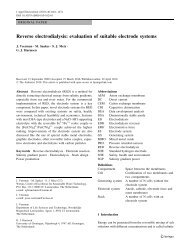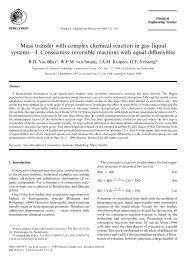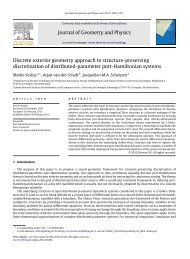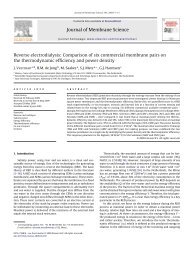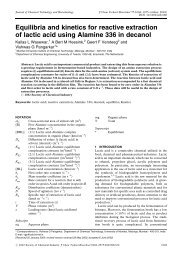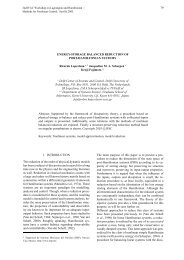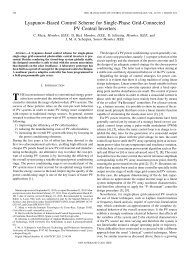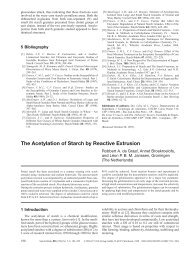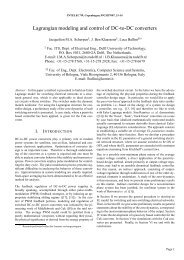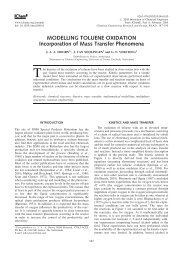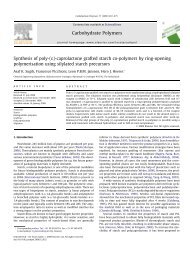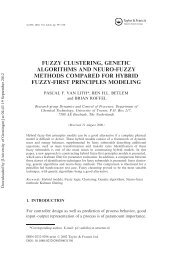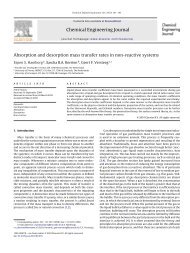Mass transfer with complex chemical reaction in gas—liquid ... - ITM
Mass transfer with complex chemical reaction in gas—liquid ... - ITM
Mass transfer with complex chemical reaction in gas—liquid ... - ITM
- No tags were found...
You also want an ePaper? Increase the reach of your titles
YUMPU automatically turns print PDFs into web optimized ePapers that Google loves.
R.D. Vas Bhat et al./Chemical Eng<strong>in</strong>eer<strong>in</strong>g Science 54 (1999) 137—147 143Fig. 6. (a) Concentration profiles at position III: r "0.01. Profiles at end of the contact time. Ha"5790; E "8.19. (b) Concentration profiles atposition III: r "10. Profiles at end of the contact time. Ha"5790; E "7.99.K , determ<strong>in</strong>e the concentrations of all components. Fora case of lower mobility of C [r "0.01; Fig. 7(a)], concentrationof C near the <strong>in</strong>terface is very low due to thetransport limitation of C towards the <strong>in</strong>terface. Thiscomb<strong>in</strong>ed <strong>with</strong> the high concentration of E (and F) nearthe <strong>in</strong>terface forces the concentration of A to rise <strong>in</strong> thevic<strong>in</strong>ity of the <strong>in</strong>terface, which opposes the absorption ofA and reduces the enhancement factor. In order to verifythis hypothesis, simulations <strong>with</strong> identical process parametersand <strong>with</strong> <strong>reaction</strong> (1c) ma<strong>in</strong>ta<strong>in</strong>ed irreversiblewere carried out (Fig. 8). The enhancement factor, <strong>in</strong> thiscase, does not reduce beyond position III, confirm<strong>in</strong>gthat the reduction <strong>in</strong> the case of lower mobility is causedby the equilibrium constra<strong>in</strong>t of <strong>reaction</strong> (1c).This effect is not observed for higher mobilities[r "10; Fig. 7(b)], as the concentration of C near the<strong>in</strong>terface is higher (than r "0.01). This prevents an <strong>in</strong>crease<strong>in</strong> the concentration of A near the <strong>in</strong>terface eventhough the concentration of <strong>reaction</strong> products E (and F)may be high. Consequently, the <strong>in</strong>f<strong>in</strong>ite enhancementreached <strong>with</strong> high r is greater than that <strong>with</strong> a lower r .3. Influence of mass <strong>transfer</strong> factors on selectivityA number of examples of gas absorption <strong>with</strong> consecutive<strong>reaction</strong> are found <strong>in</strong> the organic process <strong>in</strong>dustry,namely the halogenation, alkylation and oxidation ofaromatic compounds. In all these cases, the selectivitytowards a particular product is desired. It has beenshown earlier (van de Vusse, 1966a, b; Hashimoto et al.,1968) that the mass <strong>transfer</strong> factors, such as k , cansignificantly <strong>in</strong>fluence selectivity <strong>in</strong> systems <strong>in</strong>volv<strong>in</strong>gconsecutive <strong>reaction</strong>s. For a review of previous research



